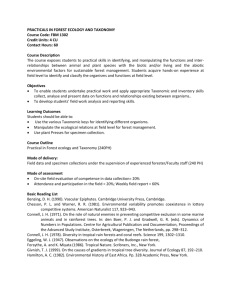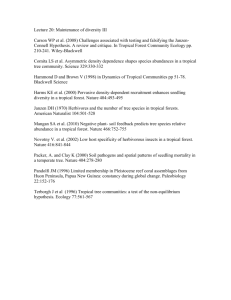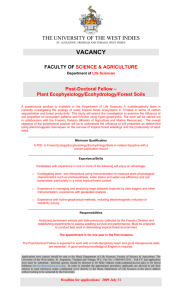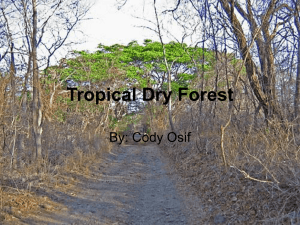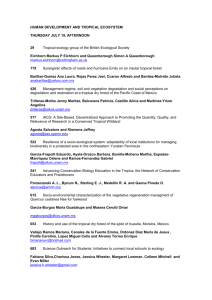Modelling the potential distribution of Tropical dry Forest in
advertisement
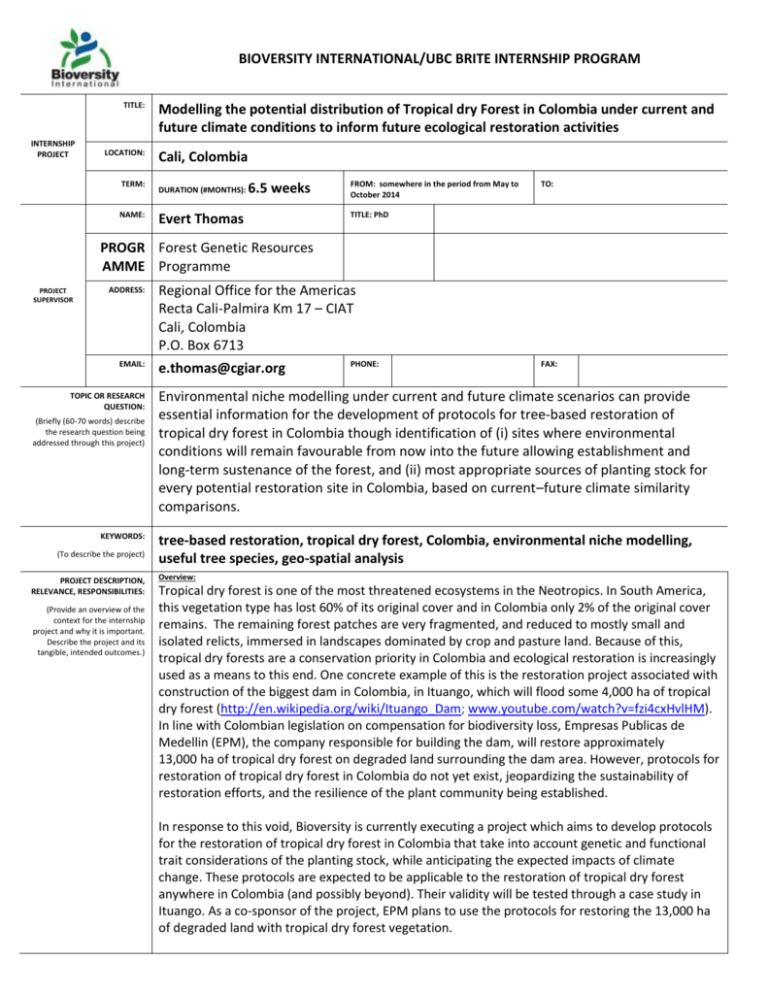
BIOVERSITY INTERNATIONAL/UBC BRITE INTERNSHIP PROGRAM TITLE: INTERNSHIP PROJECT LOCATION: TERM: NAME: Modelling the potential distribution of Tropical dry Forest in Colombia under current and future climate conditions to inform future ecological restoration activities Cali, Colombia DURATION (#MONTHS): 6.5 weeks Evert Thomas FROM: somewhere in the period from May to October 2014 TO: TITLE: PhD PROGR Forest Genetic Resources AMME Programme PROJECT SUPERVISOR ADDRESS: EMAIL: TOPIC OR RESEARCH QUESTION: (Briefly (60-70 words) describe the research question being addressed through this project) KEYWORDS: (To describe the project) PROJECT DESCRIPTION, RELEVANCE, RESPONSIBILITIES: (Provide an overview of the context for the internship project and why it is important. Describe the project and its tangible, intended outcomes.) Regional Office for the Americas Recta Cali-Palmira Km 17 – CIAT Cali, Colombia P.O. Box 6713 e.thomas@cgiar.org PHONE: FAX: Environmental niche modelling under current and future climate scenarios can provide essential information for the development of protocols for tree-based restoration of tropical dry forest in Colombia though identification of (i) sites where environmental conditions will remain favourable from now into the future allowing establishment and long-term sustenance of the forest, and (ii) most appropriate sources of planting stock for every potential restoration site in Colombia, based on current–future climate similarity comparisons. tree-based restoration, tropical dry forest, Colombia, environmental niche modelling, useful tree species, geo-spatial analysis Overview: Tropical dry forest is one of the most threatened ecosystems in the Neotropics. In South America, this vegetation type has lost 60% of its original cover and in Colombia only 2% of the original cover remains. The remaining forest patches are very fragmented, and reduced to mostly small and isolated relicts, immersed in landscapes dominated by crop and pasture land. Because of this, tropical dry forests are a conservation priority in Colombia and ecological restoration is increasingly used as a means to this end. One concrete example of this is the restoration project associated with construction of the biggest dam in Colombia, in Ituango, which will flood some 4,000 ha of tropical dry forest (http://en.wikipedia.org/wiki/Ituango_Dam; www.youtube.com/watch?v=fzi4cxHvlHM). In line with Colombian legislation on compensation for biodiversity loss, Empresas Publicas de Medellin (EPM), the company responsible for building the dam, will restore approximately 13,000 ha of tropical dry forest on degraded land surrounding the dam area. However, protocols for restoration of tropical dry forest in Colombia do not yet exist, jeopardizing the sustainability of restoration efforts, and the resilience of the plant community being established. In response to this void, Bioversity is currently executing a project which aims to develop protocols for the restoration of tropical dry forest in Colombia that take into account genetic and functional trait considerations of the planting stock, while anticipating the expected impacts of climate change. These protocols are expected to be applicable to the restoration of tropical dry forest anywhere in Colombia (and possibly beyond). Their validity will be tested through a case study in Ituango. As a co-sponsor of the project, EPM plans to use the protocols for restoring the 13,000 ha of degraded land with tropical dry forest vegetation. Two key pieces of knowledge necessary for the development of restoration protocols are (1) which sites have potential for the establishment and long-term sustenance of tropical dry forest, and (2) which sites should planting material be sourced from, taking into account anticipated climate change. One of the approaches that will be used to generate this knowledge is environmental niche modeling. The candidate will be expected to contribute to the elaboration of maps showing the distribution of the remaining areas of tropical dry forest in Colombia, as well as areas where environmental conditions are favourable to allow for its establishment and sustenance under both current and future climate conditions. Based on these maps an assessment will be made of the expected change in climate at every potential restoration site of tropical dry Forest, and preferable sources of planting stock will be identified based on the correspondence between current and future climate conditions. For example, if at a given site average temperature is expected to rise from 25 to 30 degrees Celsius by 2070, preference could be given to sourcing planting stock from sites where the current average temperature is already around 30 degrees. To this end, the candidate, in collaboration with other team members, is expected to carry out environmental niche modeling to determine potential areas of tropical dry forest under current and future climate conditions. This will be based on: (i) presence/absence data of tropical dry forest in Colombia organized in raster maps (ii) presence points of representative species of Tropical dry Forest (iii) current climate data and different scenarios of future climate (different emission scenarios (A1, A2…) and different time projections (2030, 2050, 2070)) (iv) ensemble modeling techniques, using the following models: maximum entropy (MAXENT), boosted regression trees, random forests, generalized linear models, generalized additive models, multivariate adaptive regression splines, regression trees, artificial neural networks, flexible discriminant analysis, support vector machines and the BIOCLIM algorithm. The modeling will be implemented in the statistical program R and associated packages, mainly BiodiversityR, biomod2, dismo, raster, among others. Climate data will be obtained from the worldclim website (www.worldclim.org). Time and budget permitting, this work can be combined with field work at the restoration site in Ituango. - AVAILABLE FUNDING: NO YES IF YES, THEN LIST AMOUNT: PROJECT TYPE (Check the relevant type(s) of work to be undertaken for this internship) FIELD WORK GIS ANALYSIS (potentially if the student has the skills and interest) RESEARCH PROPOSAL DEVELOPMENT POLICY ANALYSIS LITERATURE REVIEW SURVEY DESIGN SHORT STUDY / ASSESSMENT MODEL DEVELOPMENT (research prioritization framework) DATA COLLECTION OTHER please describe: DATA / STATISTICAL ANALYSIS EXPECTED DELIVERABLES: (Summarize the intended internship project deliverables, e.g., research report, data analyzed, etc.) Maps of current observed and potential distribution of tropical dry forest in Colombia Maps of potential distribution of tropical dry forest in Colombia under different scenarios of future climate Map showing the most appropriate areas from which to source planting material for each potential restoration site, based on current–future climate similarity Research report which is expected to be the basis of a scientific publication Revised April 2009 QUALIFICATIONS AND EXPERIENCE: (List the required and desirable knowledge and experience) Good knowledge of plant ecology and tree species in particular Experience with GIS software Experience with and/or willingness to learn basic scientific programming (with R) ABOUT BIOVERSITY INTERNATIONAL Experience with distribution modelling desirable, but not essential Bioversity International undertakes, encourages and supports research and other activities on the use and conservation of agricultural biodiversity, especially genetic resources, to create more productive, resilient and sustainable harvests. Our aim is to promote the greater well-being of people, particularly poor people in developing countries, by helping them to achieve food security, to improve their health and nutrition, to boost their incomes and to conserve the natural resources on which they depend. The organization is active in over 100 countries worldwide, with more than 300 staff working from some 16 country offices. It is part of the Consultative Group on International Agricultural Research (CGIAR) which works to reduce hunger, poverty and environmental degradation in developing countries by generating and sharing relevant agricultural knowledge, technologies and policies. This research, focused on development, is conducted by a Consortium of 15 CGIAR centres working with hundreds of partners worldwide and supported by a multi-donor fund. Bioversity’s headquarters are located just outside Rome, Italy in Maccarese. http://www.bioversityinternational.org/ CONTACT FOR For more information on internship placements, contact: Per Rudebjer, a.i. Head, KMSC Unit: p.rudebjer@cgiar.org, Tel: INTERNSHIP: +39 06 6118 388


